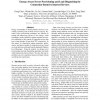NSDI
2008
14 years 1 months ago
2008
Hidden malicious circuits provide an attacker with a stealthy attack vector. As they occupy a layer below the entire software stack, malicious circuits can bypass traditional defe...
NSDI
2008
14 years 1 months ago
2008
Much recent work on Byzantine state machine replication focuses on protocols with improved performance under benign conditions (LANs, homogeneous replicas, limited crash faults), ...
NSDI
2008
14 years 1 months ago
2008
Botnets, i.e., networks of compromised machines under a common control infrastructure, are commonly controlled by an attacker with the help of a central server: all compromised ma...
NSDI
2008
14 years 1 months ago
2008
This paper presents the design, implementation, and experimental evaluation of CMAP (Conflict Maps), a system that increases the number of successful concurrent transmissions in a...
NSDI
2008
14 years 1 months ago
2008
Recent operating systems [12, 21, 26] have shown that decentralized information flow control (DIFC) can secure applications built from mostly untrusted code. This paper extends DI...
NSDI
2008
14 years 1 months ago
2008
NSDI
2008
14 years 1 months ago
2008
NSDI
2008
14 years 1 months ago
2008
Online communication media such as email, instant messaging, bulletin boards, voice-over-IP, and social networking sites allow any sender to reach potentially millions of users at...
NSDI
2008
14 years 1 months ago
2008
The primary legal obstacles to conducting cybersecurity are not outright prohibitions but rather the difficulty of determining which of a large set of complex statutes might regul...
NSDI
2008
14 years 1 months ago
2008
Energy consumption in hosting Internet services is becoming a pressing issue as these services scale up. Dynamic server provisioning techniques are effective in turning off unnece...


